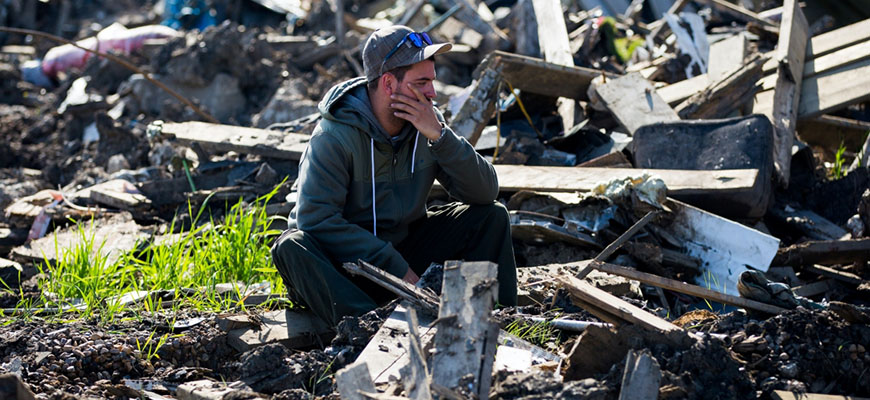
In recent years California has experienced some of the worst natural disasters in United States history. In 2017, the Tubbs fire ripped through the Sonoma, Napa, and Lake counties. In 2018, the Camp Fire, now known as the most destructive wildfire in California history, destroyed communities throughout Butte county. And now, in 2020, during a mass pandemic caused by the rapid spread of the novel coronavirus-19 (COVID-19) throughout the United States, another disaster strikes the Napa and Sonoma counties: the LNU lightning complex fires.
Natural disasters have detrimental effects on both physical and mental health, which include but are not limited to respiratory issues brought on by severe air pollution, loss of viable land for agriculture production, food insecurity, water contamination and scarcity, increased chances for heat-related illnesses, and importantly – increased rates of mental illnesses1. Stress is a significant risk factor for the development of mental illnesses2, and the stress brought on by exposure to natural disasters is no exception. People that have been exposed to natural disasters frequently report feelings of extreme fear regarding their futures, as well as fear of their imminent death3, mild to extreme insomnia3, and in some cases, the onset of mental illnesses such as post-traumatic stress disorder (PTSD), depression, and anxiety3-5. In those already diagnosed with different forms of mental illnesses, living through a natural disaster can result in worsening symptoms6. In addition, these effects are typically not acute or short-term – they are long-term7,8.
Although everyone’s mental health can be affected by the consequences of a natural disaster, those living in poor communities, the elderly, pregnant women and women in general, children, first responders, homeless populations, and those with previous mental illnesses are at the highest risk for having their mental health extremely negatively impacted by natural disasters9. In first responders, symptoms brought on after experiencing a natural disaster can be so debilitating that the suicide risk for this specific group is highly elevated10. Mental health issues can be genuinely debilitating on their own2, let alone when paired alongside the loss that comes with a natural disaster.
A key component for offsetting the effects of natural disasters on mental health is human connection and social support6,11. Unfortunately, this has been a problematic resource to maintain or even access this year. This is, of course, a result of the vast spreading of the novel virus COVID-19, which the World Health Organization (WHO) describes as “an infectious disease caused by the most recently discovered coronavirus”12. Common symptoms of the virus include fever, dry cough, tiredness, sore throat, and other flu-like symptoms12. The WHO also states that although many people (80%) recover without needing severe treatment, anyone can catch COVID-19 and become seriously ill. As there is no cure or vaccine currently available, it is recommended that people be as cautious as possible. Because of the dangers associated with contracting COVID-19, the Center for Disease Control (CDC) and the WHO strongly recommend social distancing, and in some cases, self-isolation or self-quarantine to slow the spread of the disease12.
As of September 2020, there are over 6 million confirmed cases of COVID-19 in the United States. COVID-19 is spreading through California more quickly than nearly any other state; as of this month, over 715,000 of confirmed COVID cases in the United States are in California12. It is likely that as testing becomes more readily available throughout the country, these numbers will continue to grow exponentially. The impact that the current COVID-19 induced world pandemic has had on society is unquantifiable. Consequently, the pandemic has brought on its own series of mental health issues. Surveys show that negative impacts of the pandemic on mental health began as early as March13, when social distancing recommendations were first being implemented in the United States. Very recent epidemiological and longitudinal research has shown that many different factors can be predictive of how impacted mental health will be by the pandemic in other populations.
Similar to what has been observed with natural disasters, people with pre-existing health conditions, including mental health conditions, those experiencing greater perceived risk and fear of contact, and those receiving less social support show a more considerable degree of worsening mental health14. Further research shows that people with mental illnesses have increased anxiety regarding the impact of the pandemic on their futures15, and many different populations of people in the United States show significant levels of concern about their livelihoods, the economic climate, and the job market16.
The unusual levels of isolation resulting from implementing the recommended protective measures have brought on feelings of loneliness and depression in different populations17. In fact, recent reports show that the prevalence of depression symptoms has increased three-fold during the pandemic18. An additional unfortunate complication is a burden the pandemic has put on our health care system. Research conducted across all 50 states shows that many health care professionals, including nurses, physicians, respiratory therapists, and advanced practice providers, fear that the current lack of resources makes it so that hospitals are unable to keep providers safe19. These health care providers also report poor communication between staff and supervisors, and concerns about transmitting COVID-19 to communities outside of the hospital, including family members19. The lack of personal protective equipment (PPE) is a leading reason why these hospital staff across the United States believe they may be further transmitting this disease19. This is an extreme public health issue, as it does indeed suggest a strong possibility for further spread of a disease for which there is no vaccine. This is especially problematic in states like California, where destructive wildfires are having an additional detrimental effect on property, communities, and the physical and mental wellbeing among many California residents.
Currently, residents of areas throughout Northern California, specifically Sonoma county, are dealing with the aftereffects of a mostly but not entirely contained wildfire, which broke out after a lightning storm hit in these counties20. This wildfire was large enough to destroy many areas throughout various counties, including some parts of National parks. They also raised the air quality index of these areas to unhealthy levels and forced people to evacuate their homes. Not only will this have damaging effects on the mental health of those effected, but it also has very real impacts for physical health and the continued spread of COVID-19. Mass evacuations throughout various areas in these counties were being enforced for some time, and in some areas within Sonoma county, evacuation warnings are still in place21. This makes it nearly impossible to continue to safely social distance between communities. In addition, this makes it impossible to keep track of contact tracing – another mechanism that is suggested to be in use for the containment of COVID-19. Domestic travel, even within states, is in general not recommended under most cases as it puts people at greater risk of exposure to the virus; however, during this natural disaster, domestic travel is unavoidable. In order to maintain safety from the virus, people are being asked to stay in their homes, but in order to gain safety from the wildfires, many people have been ordered to evacuate and be displaced from their homes. Inevitably, the combination of mass evacuations and displacement, with many people likely staying in shelters with large groups of strangers, will cause increased anxiety along with prolonged exposure and prolonged spread of COVID-19 throughout these communities. The stress of natural disasters and home destabilization is immense in and of itself, but during a mass pandemic, is indefinable.
During times like this, it is more important than ever to find ways to stabilize our lives and improve our circumstances in any way we can to circumvent negative impacts to our mental health. Some commonly recommended mechanisms for improving mental health include adopting coping strategies, such as those that are focused on positive prospects for the future13, which can be obtained through implementing practices such as mindfulness in your daily life22. Other suggestions include increasing physical activity, which is commonly known to help promote a positive mindset and may be especially useful for raising moods during times of prolonged social isolation23,24. It may be challenging with poor air quality due to the wildfires to do outdoor exercises such as jogging, walking or hiking. Moreover, using gymnasiums will be quite challenging with the pandemic. It is useful during the current times to continue an exercise regimen in one’s home using a stationary bike, treadmill, or through practicing yoga and other home-based exercises. Maximizing movement while waiting, changing your workstation, such as by use of a standing desk, and other small changes, are small but incremental ways to help your mood24. Another method that has been implemented widely is therapy through videoconferencing and other telecommunication resources. This form of therapy has already been shown to be beneficial for people struggling with symptoms such as PTSD, depression, and anxiety 25,26. Cognitive behavioral therapy, which can be useful for practicing mindfulness22, and is typically widely used for helping patients find relief in their symptoms, has also successfully been implemented through videoconferencing25,26.
Given the compounding nature of living through both a natural disaster and a mass pandemic, it is important to highlight the risk for the development of PTSD. The extreme levels of stress these events bring on can lead to unsettling feelings of alarm, loss, distress, agitation, and even anger. These reactions are completely normal, but in some cases, they can become unmanageable; this is particularly the case for anger27. When these symptoms become unmanageable, it is important to seek help for PTSD from trained professionals or other vetted services. Veteran Affairs (VA) has tools for coping with PTSD after natural disasters28, such as guides focused on what to expect during or following a natural disaster, suggestions for keeping on top of self-care, and how to manage when faced with triggers. Additionally, the VA has developed an app called PTSD Coach29 which is specially designed to help with recognizing, learning about, and managing symptoms of PTSD. When used together with professional medical treatment, PTSD Coach can aid in handling various symptoms.
There are many options available for improving mental health following a natural disaster; It is imperative during times of such unique and extreme stress that we remember to use whatever methods we have available to safeguard our mental health and take care of ourselves.
References:
- Krawisz, B. Health effects of climate destabilization: understanding the problem. WMJ. 2020 June; 119(2): 132-138.
- Cirulli, F., Laviola, G., Ricceri, L. Risk factors for mental health: current approaches in translational neuroscience. Neurosci Biobehav Rev. 2009 April; 33(4): 493-497.
- Psarros, C., Theleritis, C., Economous, M., Tzavara, C., Kioulous, K. T., Mantonakis, L., Soldatos, C. R., Bergiannaki, J. Insomnia and PTSD one month after wildfires: evidence for an independent role of the “fear of imminent death”. Int J Psychiatry Clin Pract. 2017 June; 21(2): 137-141.
- Randolph, R., Chacko, S., Morsch, G. Disaster medicine: public health threats associated with disasters. FP Essent. 2019 Dec; 487: 11-16.
- Bates, M. Natural disasters, and public health. IEEE Pulse. 2019 Mar-April; 10(2): 24-27.
- Felix, E. D., Afifi, W. The role of social support on mental after multiple wildfire disasters. J Comm Psychology. 2015 Jan 27; 43(2): 156-170.
- Belleville, G., Ouellet, M., Morin, C.M. Post-traumatic stress among evacuees from the 2016 fort mcmurray wildfires: an exploration of psychological and sleep symptoms three months after the evacuation. Int J Environ Res Public Health. 2019 May 8; 16(9): 1604.
- McFarlane, A. C., Van Hoof, M. Impact of childhood exposure to a natural disaster on adult mental health: a 20-year longitudinal follow-up study. Br J Psychiatry. 2009 Aug; 195(2): 142-148.
- Medical Alert! Climate Change Is Harming Our Health. The Medical Society Consortium on Climate and Health. Published March 15, 2017. Accessed September 4, 2020. https://medsocietiesforclimatehealth.org/reports/medical-alert
- Stanley, I. H., Hom, M. A., Gai, A. R., Joiner, T. E. Wildland firefighters, and suicide risk, examining the role of social disconnectedness. Psychiatry Res. 2018 Aug; 266: 269-274.
- Connerton, C. S., Wooton, A. K. Building community resilience to mitigate the mental health effects of climate change. Create Nurs. 2019 Aug 15; 25(3): 9-14.
- World Health Organization. Published on April 17, 2020. Accessed September 4, 2020. https://www.who.int/emergencies/diseases/novel-coronavirus-2019/question-and-answers-hub/q-a-detail/q-a-coronaviruses
- Marroquin, B., Vine, V., Morgan, R. Mental health during the COVID-19 pandemic: effects of stay-at-home policies, social distancing behavior, and social resources. Psychiatry Res. 2020 Aug 20; 293: 113419.
- Zhou, Y., MacGeorge, E. L., Myrick, J. G. Mental health and its predictors during the early months of the COVID-19 pandemic experience in the United States. Int J Environ Res Public Health. 2020 Aug 31; 17(17): E6315.
- Costa, M., Pavlo, A., Reis, G., Ponte, K., Davidson, L. COVID-19 concerns among persons with mental illness. Psychiatr Serv. 2020 Sep 3;appips202000245.
- Kim, H. H.., Laurence, K. COVID-19 restrictions and mental distress among American adults: evidence from corona impact survey (W1 and W2). J Public Health (Oxf). 2020 Sep 3; fdaa148.
- Roy, A., Singh, A. K., Mishra, S., Chinnadurai, A., Mitra, A., Bakshi, O. Mental health implications of COVID-19 pandemic and its response in India. Int J Soc Psychiatry. 2020 Sep 1; 20764020950769.
- Ettman, C. K., Abdalla, S. M., Cohen, G. H., Sampson, L.Vivier, P. M., Galea, S. Prevalence of depression symptoms in US Adults before and during the COVID-19 pandemic. JAMA Netw Open. 2020 Sep 1; 3(9): e2019686.
- Sharma, M., Creutzfeldt, C. J., Lewis, A., Patel, P. V., Hartog, C., Jannotta, G. E., Blissitt, P., Kross, E. K., Kassebaum, N., Greer, D. M., Curtis, J. R., Wahlster, S. Healthcare professionals’ perceptions of critical resource availability and factors associated with mental well-being during COVID-19: results from a US survey. Clin Infect Dis. 2020 Sep 2;ciaa1311.
- Cal Fire. Published Aug 18, 2020. Updated Sep 4, 2020. Accessed Sept 4, 2020. https://www.fire.ca.gov/incidents/
- SoCo Emergency. Evacuation Orders Updates. Published Aug 25, 2020. Updated Sep 4, 2020. Accessed Sept 4, 2020. https://socoemergency.org/evacuation-update/
- Khaiyom, J. H. A. Managing mental health in pandemic COVID-19 and movement control order. Malays J Med Sci. 2020 Jul; 27(4): 147-153.
- Khoramipor, K., Basereh, A., Hekmatikar, A. A., Castell, L., Ruhee, R. T., Suzuki, K. Physical activity and nutrition guidelines to help with the fight against COVID-19. J Sports Sci. 2020 Aug 25; 1-7.
- Diamond, R., Byrd, E. Standing up for health – improving mental wellbeing during COVID-19 isolation by reducing sedentary behavior. J Affect Disord. 2020 Aug 12; 277: 12312.
- Wells, S. Y., Morland, L. A., Wilhite, E. R., Grubbs, K. M., Rauch, S. A. M., Acierno, R., McLean, C. P. Delivering prolonged exposure therapy via videoconferencing during the COVID-19 pandemic: an overview of the research and special considerations for providers. J Trauma Stress. 2020 Aug; 33(4): 380-390.
- Inchausti, F., MacBeth, A., Hasson-Ohayon, I., Dimaggio, G. Psychological intervention, and COVID-19: what we know so far and what we can do. J Contemp Psychother. 2020 May 27; epub: 1-8.
- S. Department of Veteran Affairs. Accessed Oct 30, 2020. https://www.ptsd.va.gov/understand/related/anger.asp
- S. Department of Veteran Affairs. Accessed Oct 30, 2020. https://www.ptsd.va.gov/understand/types/resources_disaster_violence.asp
- S. Department of Veteran Affairs. Accessed Oct 30, 2020. https://www.ptsd.va.gov/appvid/mobile/ptsdcoach_app.asp

